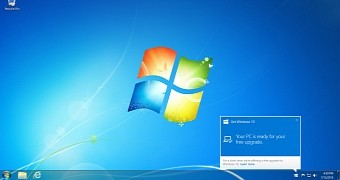Microsoft launched Windows 10 on July 29, 2015, with the mission of bringing it on 1 billion devices by 2017, including here desktop computers, laptops, tables, and smartphones.
Yesterday, the company revealed that after 9 months since launch, Windows 10 was running on 300 million devices across the world, which makes it the fastest adopted operating system ever released by Microsoft.
The software giant has been saying the same thing since 2015 and comparison stats after 9 months on the market indeed seem to indicate that Windows 10 recorded better adoption figures than Windows 7, which is generally referred to as the most successful Windows version to date (together with the outdated Windows XP, of course).
Figures put together by VB show that Windows 10 needed exactly 281 days (approximately 9 months) to reach 300 million installs (between July 29, 2015, and May 5, 2016), while Windows 7 did the same in 462 days (about 15 months) between October 22, 2009, and January 27, 2011. This means that Windows 10 was installed on 300 million devices 181 days (six months) faster than Windows 7.
30 million installs in just one month
Microsoft provided similar figures in late March when Windows 10 was installed on 270 million devices (this means that in approximately one month, the new operating system improved the figure by 30 million).
“In the eight months since launch, Windows 10 is off to the fastest start in Windows history, with over 270 million active devices, outpacing Windows 7 in the same timeframe by 145%. People are spending more time on Windows than ever before – over 75 billion hours – with the highest customer satisfaction of any version of Windows,” Terry Myerson, head of the OS group at Microsoft, said in March.
So is the 1 billion devices goal still possible given the fact that Microsoft is getting ready to pull the plug on its free upgrade offer in July? Myerson says it is, probably because enterprises are also expected to begin the transition anytime soon.
“We are on track to reach our ambitious goal of one billion Windows 10 devices in the next few years. We welcome everyone to Windows 10,” Myerson concluded.
Is Microsoft’s aggressive push for Windows 10 the reason for faster adoption?
As for the reasons why Windows 10 adoption is improving at such a faster pace, Microsoft explains that the number of new features that are part of the operating system is what convinces users to upgrade their PCs and smartphones.
But on the other hand, users blame Microsoft for its aggressive Windows 10 push and the nags that are displayed on Windows 7 and 8.1 computers in order to force the upgrade even if users refuse to do it.
Microsoft rolled out the Get Windows 10 app in mid-2015 in an attempt to offer a smooth transition from Windows 7 and 8.1 to the new OS, but the app has been responsible for quite a few accidental upgrades, with some users claiming that their PCs started installing Windows 10 without prior notice.
Whatever the reason, Microsoft’s plan to bring Windows 10 on as many PCs as possible seems to be working, but time will tell if this is the right strategy on the long term.

 14 DAY TRIAL //
14 DAY TRIAL //